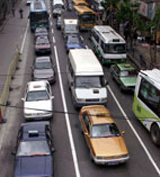 Studies have found that the pollution caused by one low-tech Chinese car is equal to the pollution of four Euro 1 cars and some 20 Euro 3 cars
Studies have found that the pollution caused by one low-tech Chinese car is equal to the pollution of four Euro 1 cars and some 20 Euro 3 cars
For most of Shanghai's urban dwellers, fresh air is a luxury. Statistics show that last year the city had only 58 days of clean air.
The rest of the time, local residents were forced to endanger their lives by breathing the polluted air spewed from factories and motor vehicles.
Over the past few years, the city has attempted to improve air quality through various campaigns, such as closing down heavy industry located near the city and eliminating coal stoves.
However, the main accomplishment, the reduction of sulfur dioxide emissions, has been countered by the increasing levels of nitrogen oxide from vehicle emissions.
A report released by Shanghai Environmental Protection Bureau shows the concentration of nitrogen oxide in the air climbed by 0.002 mg per cubic metre - a level equivalent to the declining rate of sulfur dioxide - compared to the year 2000, which brought its average concentration to 0.044 mg per cubic metre.
Apart from nitrogen oxide, the city's 1.2 million automobiles are also contributing to some 90 per cent of the carbon monoxide and hydrocarbons in the air.
Meanwhile, the number of vehicles on Shanghai roads is increasing by 14 per cent annually with future growth set to hit even higher levels, as the industry takes off under the support of the government and expanding consumer consumption.
"Just recently, the central government has moved to cut certain fees for car owners to encourage sales," Cai Zhigang, research fellow at Shanghai Environmental Protection Bureau, said.
Mixed feelings
"I have mixed feelings about the development of the automobile industry," Cai said.
"Cars bring convenience to people, and fuel the growth of the economy, but there are other concerns, like the growing number of automobile accidents and the environmental degradation."
Vehicle exhaust is, of course, in direct contact with people, affecting public health more directly than factory emissions.
The particles emitted into the air can quickly enter the human respiratory organs, damaging the lower respiratory tract and lungs, even causing cancer.
A survey conducted in Guangzhou found that workers on average take 6-days of sick leave every year due to illnesses caused by air pollution, and about 1,600 die prematurely each year from air pollution related diseases.
Shanghai also faces a big problem, having an even larger number of automobiles - 100,000 more than Guangzhou according to statistics.
Jiang Wei, a man in his 40s, is among those suffering most from the city's vehicle related pollution. The owner of a roadside restaurant on Yuyuan Lu, Jiang has to watch hundreds of cars and buses pass his small shop every day.
"Not a single breath taken here is free from the smell of oil," Jiang said.
"In recent years, I often feel weakness in my heart, nothing but the polluted air could cause it."
In Shanghai suffers like Jiang are not rare. According to Pang Zhonghua, director of respiratory department of Shanghai Huadong Hospital, the number of people suffering from asthma is rising at an annual rate of 3 per cent with air pollution as a main cause.
Lagging behind
Of the 1.2 million vehicles in Shanghai, only 20 per cent of them meet the Euro 1 standard - a standard adopted by European countries in 1992.
The majority meet the old national standard, which allows four times the amount of pollutants as Euro 1 to be emitted in automobile exhaust.
It will take at least eight years before these old cars are off the roads, while in most western European countries, standards like Euro 3 are already in effect.
Studies have found that the pollution caused by one low-tech Chinese car is equal to the pollution of four Euro 1 cars and some 20 Euro 3 cars.
Although, from the perspective of environmental friendliness, the faster older model cars are off the road the better, the government has prolonged some vehicles' valid driving term to promote the industry.
In the past, the legal lifespan of an individual car was 12 years. The new rule allows 9-seat below family sedans and mini-wagons to continue in use, as long as they meet certain safety and environmental requirements at annual checkups.
"It has, to some degree, made our job more difficult," Cai said.
In many western countries, the lifespan of the average car is short, as governments create policies to encourage car owners to purchase new models. However, in China there are no such flexible policies.
"It is the main reason why in big cities like Tokyo, where there are almost three times the number of cars, air quality is better than here," said Cai.
Yet China is also trying to come closer to the standards of developed countries.
It has set a three-step process for auto emissions: following the adoption of Euro 1 in 2000, the country aims to apply the Euro 2 standard by 2005 to new cars, which will see a 50 per cent cut in pollutants from Euro 1, and by 2010 new cars in China must meet whatever advanced emission standard Western countries are following at that time.
Shanghai Municipal government, to apply micro-control to the increasing number of cars, is planning to double its elevated train and subway system to more than 200 km of track, which will not only help Shanghai's commuters but also its environment.
"Anyway no one here wants to see their city become so dirty that it can't even be detected by satellite," Cai said.
(Shanghai Star May 9, 2002)
